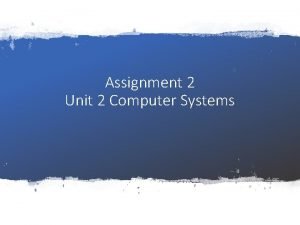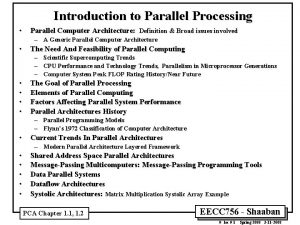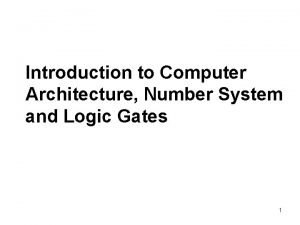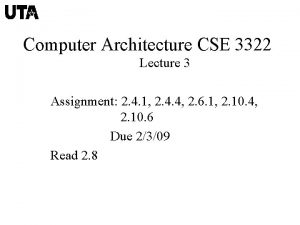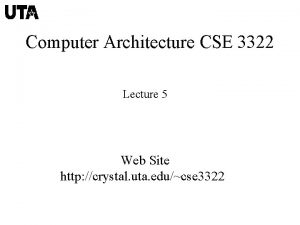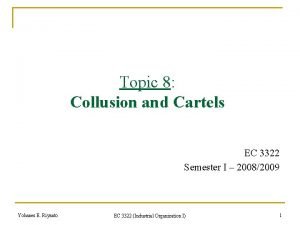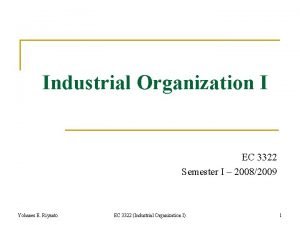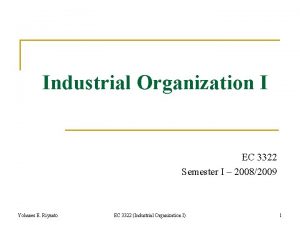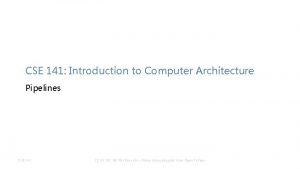Computer Architecture CSE 3322 Lecture 4 Assignment 2







































- Slides: 39

Computer Architecture CSE 3322 Lecture 4 Assignment: 2. 4. 1, 2. 4. 4, 2. 6. 1, 2. 10. 4, 2. 10. 6 Due 2/10/09 http: //crystal. uta. edu/~cse 3322

Case / Switch Statement switch ( k ) { case 0: statement 0; break case 1: statement 1; break case 2: statement 2; break}

Case / Switch Statement switch ( k ) { case 0: statement 0; break case 1: statement 1; break case 2: statement 2; break } if k < 0, then Exit slt set on less than slt rd, rs, rt means if rs < rt, rd = 1, else rd=0

Case / Switch Statement switch ( k ) { case 0: statement 0; break case 1: statement 1; break case 2: statement 2; break } if k < 0, then Exit slt set on less than slt rd, rs, rt means if rs < rt, rd = 1, else rd=0 So, if k ~ $s 0 slt $t 0, $s 0, $zero # $t 0 = 1 if k < 0 bne $t 0, $zero, Exit # goto Exit if k < 0

Case / Switch Statement switch ( k ) { case 0: statement 0; break case 1: statement 1; break case 2: statement 2; break } if k < 0, then Exit slt set on less than slt rd, rs, rt means if rs < rt, rd = 1, else rd=0 So, if k ~ $s 0 slt $t 0, $s 0, $zero # $t 0 = 1 if k < 0 bne $t 0, $zero, Exit # goto Exit if k < 0 And the test for k > 2 is, assuming $s 1 = 3 slt $t 0, $s 1 # $t 0 = 1 if k < 3 beq $t 0, $zero, Exit # goto Exit if k >=3

Case / Switch Statement switch ( k ) { case 0: statement 0; break case 1: statement 1; break case 2: statement 2; break } Jump. Table[ k ] addr of statement 2 addr of statement 1 addr of statement 0 For a given k, place Jump. Table[ k ] in register $t 0 using lw instruction

Case / Switch Statement switch ( k ) { case 0: statement 0; break case 1: statement 1; break case 2: statement 2; break } Jump. Table[ k ] addr of statement 2 addr of statement 1 addr of statement 0 load Jump. Table[ k ] in a register and jump to it jr jump register jr rs means go to address in register rs

Case / Switch Statement switch ( k ) { case 0: statement 0; break case 1: statement 1; break case 2: statement 2; break } slt bne slt beq Exit: k is in $s 0, Start of Jump. Table is in $t 1 $t 0, $s 0, $zero # $t 0 = 1 if k < 0 $t 0, $zero, Exit # goto Exit if k < 0 $t 0, $s 1 # $t 0 = 1 if k < 3 $t 0, $zero, Exit # goto Exit if k >=3

Case / Switch Statement switch ( k ) { case 0: statement 0; break case 1: statement 1; break case 2: statement 2; break } slt bne slt beq add add lw jr Exit: k is in $s 0, Start of Jump. Table is in $t 1 $t 0, $s 0, $zero # $t 0 = 1 if k < 0 $t 0, $zero, Exit # goto Exit if k < 0 $t 0, $s 1 # $t 0 = 1 if k < 3 $t 0, $zero, Exit # goto Exit if k >=3 $t 0, $s 0 # $t 0 = 2 * k $t 0, $t 0 # $t 0 = 4 * k $t 0, $t 1 # $t 0 = addr of Jump. Table[k] $t 2, 0( $t 0) # $t 2 = Jump. Table[k] $t 2 # jump to addr in $t 2

MIPS Assembly Instructions Pseudo instructions Instructions supported by the Assembler but not implemented in hardware. Ex: move multiply branch less than, less than or equal, greater than or equal

MIPS Immediate Addressing Very common to use a constant in arithmetic operations. Examples? Make it faster to access small constants. Keep the constant in the instruction. add immediate addi $s 1, $s 2, constant op rs rt $s 1 = $s 2 + constant immediate 8 18 17 constant 6 5 5 16 I type of format The constant can be negative!

MIPS Immediate Addressing Very common to use a constant in comparison operations. Examples? Make it faster to do comparisons. Keep the constant in the instruction slt immediate slti $t 0, $s 2, constant rt $t 0 = 1 if $s 2 < constant else $t 0 = 0 op rs 10 18 8 constant 6 5 5 16 I type of format immediate

Procedure Calls 1. Place parameters where the procedure can access them

Procedure Calls 1. Place parameters where the procedure can access them 2. Transfer control to the procedure

Procedure Calls 1. Place parameters where the procedure can access them 2. Transfer control to the procedure 3. Perform the task of the procedure

Procedure Calls 1. 2. 3. 4. Place parameters where the procedure can access them Transfer control to the procedure Perform the task of the procedure Place the results where the calling program can access them

Procedure Calls 1. 2. 3. 4. Place parameters where the procedure can access them Transfer control to the procedure Perform the task of the procedure Place the results where the calling program can access them 5. Return control to the point of the call

Procedure Calls 1. 2. 3. 4. Place parameters where the procedure can access them Transfer control to the procedure Perform the task of the procedure Place the results where the calling program can access them 5. Return control to the point of the call Allocate registers to hold data for procedure calls $a 0 - $a 3 : four registers to pass parameters $v 0 - $v 1 : two registers to return values $ra : one return address register

Procedure Calls 1. 2. 3. 4. Place parameters where the procedure can access them Transfer control to the procedure Perform the task of the procedure Place the results where the calling program can access them 5. Return control to the point of the call Allocate registers to hold data for procedure calls $a 0 - $a 3 : four registers to pass parameters $v 0 - $v 1 : two registers to return values $ra : one return address register Need jump-and-link instruction : jal Procedure. Address means : save return address in $ra and jumps to Procedure. Address

Procedure Calls 1. 2. 3. 4. Place parameters where the procedure can access them Transfer control to the procedure Perform the task of the procedure Place the results where the calling program can access them 5. Return control to the point of the call Allocate registers to hold data for procedure calls $a 0 - $a 3 : four registers to pass parameters $v 0 - $v 1 : two registers to return values $ra : one return address register Need jump-and-link instruction : jal Procedure. Address means : save return address in $ra and jumps to Procedure. Address How do you return?

Compiling a “leaf” Procedure (Does not Call another Procedure) int leaf_example ( int g, int h, int i, int j) { int f ; f=(g+h)–(i+j); return f ; }

Compiling a “leaf” Procedure (Does not Call another Procedure) int leaf_example ( int g, int h, int i, int j) { int f ; f=(g+h)–(i+j); return f ; } Assign g to $a 0, h to $a 1, i to $a 2, j to $a 3 and f to $v 0.

Compiling a “leaf” Procedure (Does not Call another Procedure) int leaf_example ( int g, int h, int i, int j) { int f ; f=(g+h)–(i+j); return f ; } Assign g to $a 0, h to $a 1, i to $a 2, j to $a 3 and f to $v 0. Leaf_example: add $t 0, $a 1 # Temp $t 0 = g + h add $t 1, $a 2, $a 3 # Temp $t 1 = i + j sub $v 0, $t 0 , $t 1 # $v 0 = (g+h) – (i+j) jr $ra # jump back to calling routine

Compiling a “leaf” Procedure (Does not Call another Procedure) int leaf_example ( int g, int h, int i, int j) { int f ; f=(g+h)–(i+j); return f ; } Assign g to $a 0, h to $a 1, i to $a 2, j to $a 3 and f to $v 0. Leaf_example: add $t 0, $a 1 # Temp $t 0 = g + h add $t 1, $a 2, $a 3 # Temp $t 1 = i + j sub $vo, $t 0 , $t 1 # $v 0 = (g+h) – (i+j) jr $ra # jump back to calling routine What if the calling procedure uses $t 0 and $t 1?

Procedure Calls How can we preserve “saved registers” of the calling procedure ? What if there are not enough registers allocated to pass parameters and values ?

Procedure Calls Store the registers in memory using a stack. push $s 0 High pop $s 0 Stack $sp Low $sp contents of $s 0 $sp

Stack Processes • A stack is a last-in-first-out queue

Stack Processes • A stack is a last-in-first-out queue • The stack pointer, $sp, points to the most recently allocated address.

Stack Processes • A stack is a last-in-first-out queue • The stack pointer, $sp, points to the most recently allocated address. • By convention, stacks grow from higher addresses to lower addresses.

Stack Processes • A stack is a last-in-first-out queue • The stack pointer, $sp, points to the most recently allocated address. • By convention, stacks grow from higher addresses to lower addresses. • To push $s 0, $s 1, and $s 2, first reduce $sp three words and then save the registers.

Push on the Stack addi $sp, -12 sw $s 2, 8($sp) sw $s 1, 4($sp) sw $s 0, 0($sp) High $sp Low # adjust stack pointer 3 words # store $s 2 at $sp + 8 # store $s 1 at $sp + 4 # store $s 0 at $sp push $s 2, $s 1, and $s 0 contents of $s 2 contents of $s 1 $sp contents of $s 0 $sp

Pop off the Stack lw lw lw addi $s 0, 0($sp) $s 1, 4($sp) $s 2, 8($sp) $sp, 12 # restore $s 0 from $sp # restore $s 1 from $sp + 4 # restore $s 2 from $sp + 8 # adjust stack pointer 3 words pop $s 0, $s 1, and $s 2 High $sp Low contents of $s 2 contents of $s 1 $sp contents of $s 0 $sp

Procedure Call 1. Save the registers used by the procedure by pushing on the stack at the start High $sp Low push $s 2, $s 1, and $s 0 pop $s 0, $s 1, and $s 2 contents of $s 1 $sp contents of $s 0 $sp

Procedure Call 1. Save the registers used by the procedure by pushing on the stack at the start 2. Restore the registers used by the procedure by popping off the stack at the end High $sp Low push $s 2, $s 1, and $s 0 pop $s 0, $s 1, and $s 2 contents of $s 1 $sp contents of $s 0 $sp

Procedure Call Also data and results can be transferred between the procedure and calling program using the stack High $sp Low push $s 2, $s 1, and $s 0 pop $s 0, $s 1, and $s 2 contents of $s 1 $sp contents of $s 0 $sp

Procedure Call Conventions By agreement the following registers are preserved: • Saved Registers: $s 0 - $s 7 • Return Address: $ra Which means that the called routine must return to the calling program with these registers unchanged. If the called routine changes any of these ( includes calling a routine) it must first save them on the stack and restore them upon return.

Procedure Call Conventions By agreement the following registers are preserved: • Saved Registers: $s 0 - $s 7 • Return Address: $ra Which means that the called routine must return to the calling program with these registers unchanged. If the called routine changes any of these ( includes calling a routine) it must first save them on the stack and restore them upon return. The stack must be kept correct, so the Stack Pointer, $sp, and the Stack above the Stack Pointer must be the same across the procedure call.

Procedure Call Conventions By agreement the following registers are not preserved: • Temporary Registers: $t 0 - $t 9 • Argument Registers: $a 0 - $a 3 • Return Value Registers: $v 0 - $v 1 • Stack below the stack pointer Which means that the calling routine must push any of these registers on the stack that are needed after the call. Why not just push all the registers on the stack ? When would this be necessary ?

MIPS Register Conventions Name Register Usage Preserved Number Across Call $zero 0 constant 0 na $v 0 -$v 1 2 -3 values for results no $a 0 -$a 3 4 -7 arguments no $t 0 -$t 7 8 -15 temporaries no $s 0 -$s 7 16 -23 saved yes $t 8 -$t 9 24 -25 more temporaries no $gp 28 global pointer yes $sp 29 stack pointer yes $fp 30 frame pointer yes $ra 31 return address yes Registers not listed are reserved for Assembler and OS
 +3222
+3222 Language
Language Computer architecture notes
Computer architecture notes Isa vs microarchitecture
Isa vs microarchitecture 01:640:244 lecture notes - lecture 15: plat, idah, farad
01:640:244 lecture notes - lecture 15: plat, idah, farad Buses in computer architecture
Buses in computer architecture Organization and architecture difference
Organization and architecture difference Fgi and fgo in computer architecture
Fgi and fgo in computer architecture Computer security 161 cryptocurrency lecture
Computer security 161 cryptocurrency lecture Computer aided drug design lecture notes
Computer aided drug design lecture notes Data communication and networking assignment questions
Data communication and networking assignment questions Assignment on application of computer
Assignment on application of computer Function of system unit
Function of system unit Unit 2 computer systems assignment 1
Unit 2 computer systems assignment 1 Architecture business cycle in software architecture
Architecture business cycle in software architecture Return architecture
Return architecture Integral vs modular architecture
Integral vs modular architecture Modular vs integral product architecture example
Modular vs integral product architecture example Computer organization and architecture 10th solution
Computer organization and architecture 10th solution Intel pentium
Intel pentium Coa virtual lab iit kharagpur
Coa virtual lab iit kharagpur Introduction to computer organization and architecture
Introduction to computer organization and architecture Timing and control in computer architecture
Timing and control in computer architecture Computer architecture: concepts and evolution
Computer architecture: concepts and evolution Dma controller in computer architecture
Dma controller in computer architecture Floating point division algorithm in computer architecture
Floating point division algorithm in computer architecture Absolute addressing mode in computer architecture
Absolute addressing mode in computer architecture Chordal ring
Chordal ring Smt in computer architecture
Smt in computer architecture Mips pseudo instructions
Mips pseudo instructions Collision prevention in computer architecture
Collision prevention in computer architecture Instruction format in computer architecture
Instruction format in computer architecture Nano programming
Nano programming Microprogrammed control unit in computer architecture
Microprogrammed control unit in computer architecture Memory system
Memory system Memory hierarchy
Memory hierarchy Linear pipelining in computer architecture
Linear pipelining in computer architecture Computer architecture definition
Computer architecture definition Parallel processing definition
Parallel processing definition Computer architecture number system
Computer architecture number system













